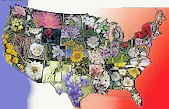Wisconsin State Flower
Wood Violet

(Viola papilionacea)
Adopted on June 4, 1949.
The Wood Violet, (Viola papilionacea,) was adopted as Wisconsin's state flower on June 4, 1949.
Wisconsin's school children were asked to vote for an official state flower in 1908, which left four finalists: arbutus, violet, white water lily and wild rose. The following year they voted again using the four finalists and the violet won. However, the violet was only named Wisconsin's unofficial state flower until 1948.
Finally, during the Centennial celebration, a youth committee was set up to officially adopt several state symbols. At this time the official flower, tree and bird were decided. On Arbor Day 1909, the final vote was taken, and the violet won. Chapter 218, Laws of 1949, which created Section 1.10 of the statutes, named the wood violet Wisconsin's official flower.
The violet is the state flower for Illinois, New Jersey, Rhode Island and Wisconsin.
Wisconsin State Flower: Wood Violet

This is the violet commonly found in yards and along roadsides. It is one of the first plants to bloom in the low, wet woods of the preserve in early spring. A perennial with heart-shaped leaves and purple flowers, most commonly 2 to 5 inches tall. Common blue violet is found throughout the eastern United States and Canada. Leaves arise from a basal crown, are heart-shaped, and occur on long petioles. Leaves are also hairless and have rounded teeth along the margins. The fruit is capsule ranging from 10 to 12 mm in length. Rhizomes and a fibrous root system. Flowers occur on stalks that do not contain leaves. Flowers consist of 5 petals that are purple or blue in color. The 2 lateral petals are bearded or hairy near the base. The identifying characteristics are the heart-shaped leaves with rounded teeth along the margins, purple flowers, and rhizomes are all features that help in the identification of common blue violet.
Characteristics of the Wood Violet
- Plant Type: This is a herbaceous plant. It is variable in flower color and to a lesser extent leaf shape.
Leaves: This plant has basal leaves only. Each heart shaped leaf is bluntly toothed and born on long stem. High in vitamins A and C it used to be a very welcome raw salad or cooked green early in the spring when fresh vegetables were hard to come by. The flowers are more often used nowadays. They can be candied and also used in jellies. - Height: Less than 1'
- Frequency: Many plants found in low woods. This is the violet commonly found in yards and along roadsides.
- Flowers: April; It is one of the first plants to bloom in the low, wet woods of the preserve in early spring. The flowers are irregular in shape . They are Deep blue or violet sometimes almost white with blue markings. Blooms first appear in early spring and continue into early fall. The side petals have beards or tuffs near the center of the flower. The flower grows on its own stem. There are also special flowers that stay near the ground and do not open...but they still produce bazillions of seeds!
- Habitat: Almost anywhere. Prefers damp locations.
- Range: Most of eastern US except extreme north and south.
Wisconsin Law
The law designating the wood violet as the official Wisconsin state flower is found in the Wisconsin Statutes, Chapter 1, Section
1.10(3)(e)
CHAPTER 1. SOVEREIGNTY AND JURISDICTION OF THE STATE.
1.10. State song, state ballad, state waltz, state dance, and state symbols.
1.10(3) The Wisconsin state symbols are as follows:
1.10(3)(a)
(a) The mourning dove (zenaidura macroura corolinensis linnaus) is the symbol of peace.
1.10(3)(b)
(b) Milk is the state beverage.
1.10(3)(c)
(c) The sugar maple (acer saccharum) is the state tree.
1.10(3)(d)
(d) Corn (Zea mays) is the state grain.
1.10(3)(e)
(e) The wood violet (viola papilionacea) is the state flower.
1.10(3)(f)
(f) The robin (turdus migratorius) is the state bird.
1.10(3)(g)
(g) The muskellunge (Esox masquinongy masquinongy Mitchell) is the state fish.
1.10(3)(h)
(h) The badger (taxidea taxus) is the state animal.
1.10(3)(i)
(i) The dairy cow (bos taurus) is the state domestic animal.
1.10(3)(j)
(j) The white-tailed deer (odocoileus virginianus) is the state wildlife animal.
1.10(3)(k)
(k) The American water spaniel is the state dog.
1.10(3)(L)
(L) The honey bee (apis mellifera) is the state insect.
1.10(3)(m)
(m) The trilobite (calymene celebra) is the state fossil.
1.10(3)(n)
(n) Galena (lead sulfide) is the state mineral.
1.10(3)(o)
(o) Red granite is the state rock
1.10(3)(p)
(p) Antigo silt loam (typic glossoboralf) is the state soil.
1.10(3)(r)
(r) The cranberry (vaccinium macrocarpon) is the state fruit.
Taxonomic Hierarchy: Wood Violet
Kingdom: Plantae - Plants
Subkingdom: Tracheobionta - Vascular plants
Superdivision: Spermatophyta - Seed plants
Division: Magnoliophyta - Flowering plants
Class: Magnoliopsida - Dicotyledons
Subclass: Dilleniidae
Order: Violales
Family: Violaceae - Violet family
Genus: Viola L. - violet
Species: Viola sororia Willd. - common blue violet
Viola papilionacea Pursh p.p --SYM
State Floral Emblems








